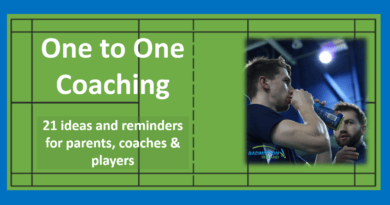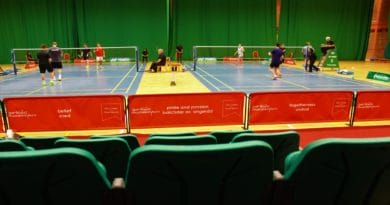BWFL1 Coaches Course – the information you need to be successful
Have you ever thought about taking a course to become a BWF Level 1 Coach?
It’s something that I believe everyone who plays or helps should consider
If you are not sure how to prepare, then hopefully these tips will help.
Do you want to explore what happens on the BWFL1 course, the things you need to know
This BWFL1 course is a fantastic way to start your coaching journey or to increase your knowledge if you are already a qualified badminton coach. Of course, this advice will not guarantee that you will be successful.
You will have to achieve the levels required.
However, if you follow and think about the tips below I’m sure you will be better prepared for all the challenges.
Trust me there will be challenges 🙂
Don’t be tempted to sit back and expect to be taught everything by the Tutor
– – – – – – – – – – – – – – – – – –
These are the key areas that I hope will help you
1. Read the resources – they are fantastic
2. Why a Mentor is a good idea
3. Practice your planning
4. The Dangers and Problems waiting for You
5. Do your homework – why it’s important
6. Shuttletime course – the benefits
.. 21 Things you need to know about the BWFL1 Coaches Course: thoughts from other coaches
– – – – – – – – – – – – – – – –
1. Read the resources
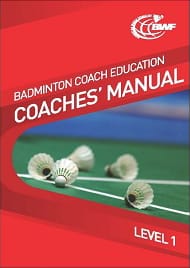 If you are considering taking a BWFL1 or a BWF Shuttletime course did you know that the resources are all online, and all the resources are free.
If you are considering taking a BWFL1 or a BWF Shuttletime course did you know that the resources are all online, and all the resources are free.
Isn’t it fantastic that BWF has allowed you not only to download the manual (in PDF) but also have lots of short videos to help you?
Sign in here to the BWF educational site and download a free Level 1 manual
I recommend that you download the manuals and that you print them out.
If you don’t want a bulky document to carry around then save a copy of the document and use something like Microsoft OneNote or Word to add your comments, tags and reminders electronically.
Whatever method you use, please read the manual and become familiar with the chapter headings. You will need this on the course. The great thing to remember that once to have it in PDF format you can easily search the content.
Online component
You will be required to complete the Online part of the BWF Level 1 before you attend the course.
Allow yourself at least 2 hours as there is plenty to read, watch and complete online
Once you’ve passed, you can download a certificate as proof. Send this to your Turor before the course.
Not only will it reinforce the material, but it will also save you and the tutor time on the course. Less listening to the Tutor and more practical coaching on the court.
Click this image and do it now. Remember to allow at least 2 hours. However, you can complete it module by module as the programme is aware of how far you complete each time you leave.
Video
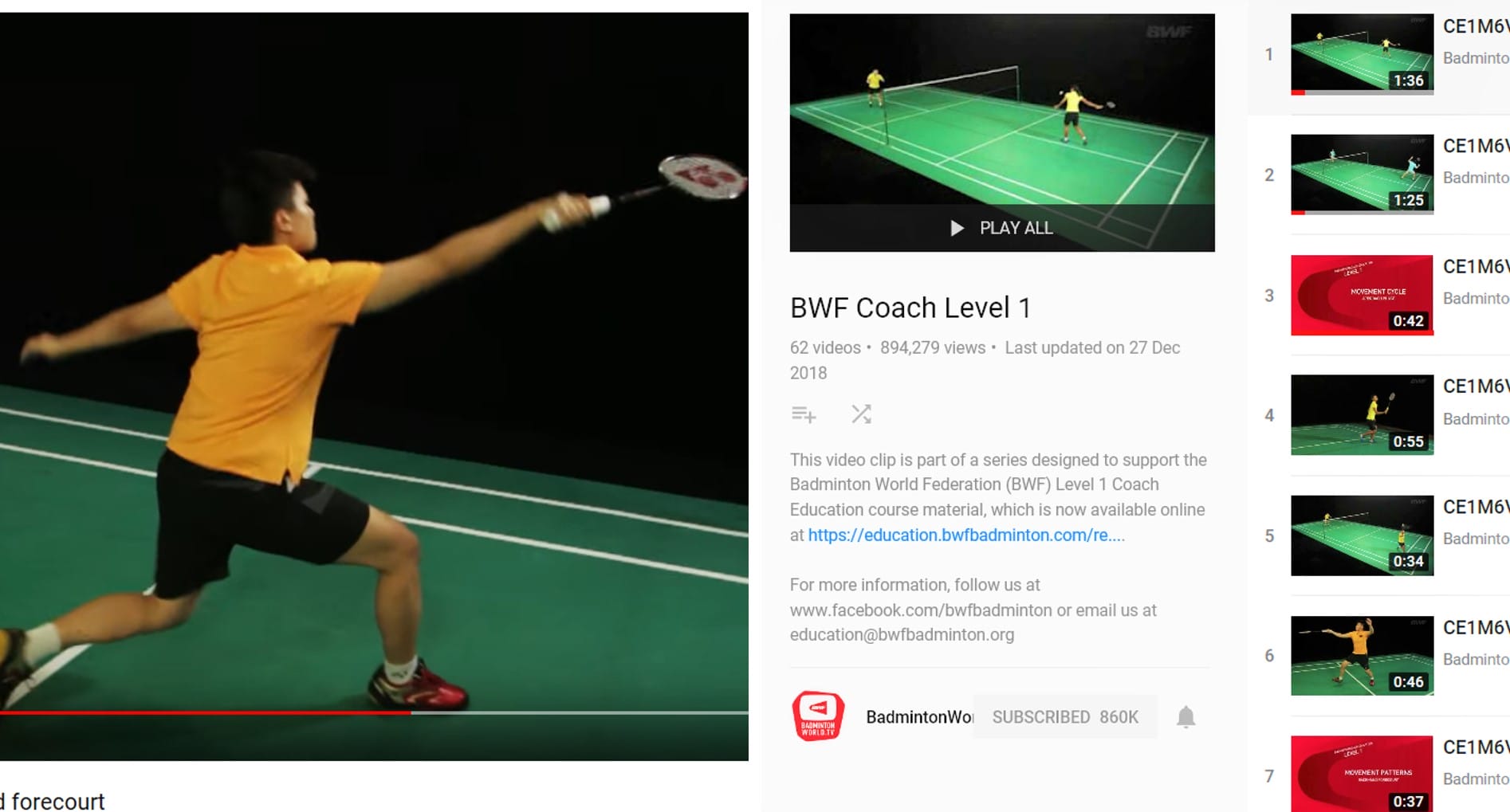 After reading this post go to YouTube and search for the BWF channel. There are so many very good videos that you will need a couple of hours to fully to appreciate the information.
After reading this post go to YouTube and search for the BWF channel. There are so many very good videos that you will need a couple of hours to fully to appreciate the information.
Nearly all of them show and describe exactly what’s written in the manual. The information is simple, direct and easy to understand.
I recommend that if you can, you download them so that you are able to view offline. This will certainly help you on the course to understand the key points that the Tutor will expect you to use during your practices.
You could think about using the videos to enhance or replace your demonstrations.
I would recommend that you seriously consider this if your demonstrations skills are not as good as you want. Please remember to practice using video demonstrations before you go on the course. It’s another skill that you can prepare for.
– – – – – – – – – – – – – – – –
2. Find a mentor
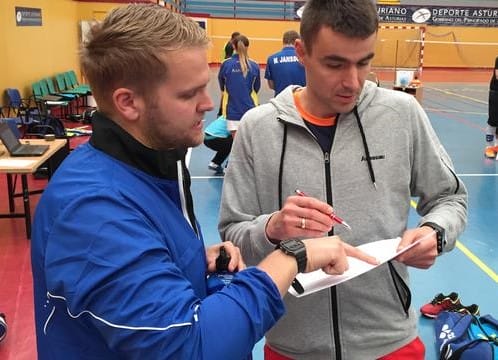 This could have been my Number 1 tip
This could have been my Number 1 tip
However, it’s your ability to understand and deliver the information that is key, not how good your mentor is!
After reading the BWFL1 manual or between Day 2 and Day 3, having a mentor to talk to is a great advantage. I recommend that you find someone who has done the course before and preferably passed!
If they were referred and had to resubmit parts of their lesson planning, that could be better. There is plenty of deep learning to be had from small ‘failures’.
Be careful when working with fellow coaches or a mentor
- It can be very easy to ask one question and then sit back and just listen.
- It’s far better if you ask a question and then be challenged to work to find solutions
- If you think working with a Badminton Mentor sounds easy, then either you have a mentor who is not challenging you or you are just listening to their thoughts.
- Reward your mentor with questions and comments
- Challenge them over areas such as how to progress a practice to make it harder or easier (its not just about increasing the duration or speed).
- Ask them if they agree with your 3 top key points that are critical for each stroke or movement
I’ve had my best coaching chat with my mentors
You may be surprised that some of them are at least 10 years younger than me
– – – – – – – – – – – – – – – –
3. Practice your planning
BWF place a big emphasis on your ability to plan and devise strategies for development.
In Level 1 the focus is on Group Lesson Planning, Goal Setting. Practice Progression and Evaluation.
The homework element may take you longer than you think. It’s not uncommon to take about 20 minutes to complete your lesson plan the first time you try. The boxes aren’t that big and you need to be precise and ‘to the point’ when you write the tasks.
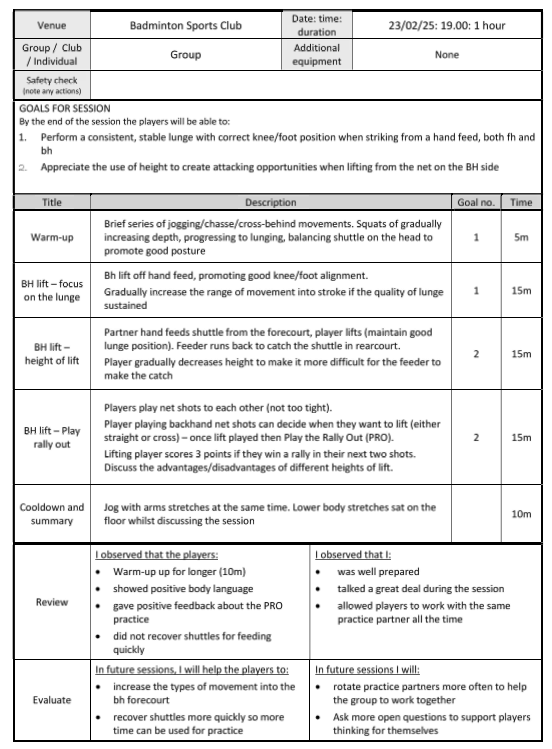 I recommend that you do all your planning using MS Word. Then if you are in doubt at any stage you can email your mentor or Tutor between Day 2 and Day 3.
I recommend that you do all your planning using MS Word. Then if you are in doubt at any stage you can email your mentor or Tutor between Day 2 and Day 3.
Ensure that you try to do the following
- Evaluate yourself honestly: your good points and your struggles
- Link to the overall goals: you will fail if you don’t do this
- Explain your tasks in detail: don’t just write ‘games’
- Link your tasks: show a progression or flow in the lesson
- Vary for warm-ups: try to replicate some of the skills and movement that you will use later
- Ensure you show the ‘Key Points’: these can be emphasised during the session
- Vary your lesson themes: not every lesson needs to be 100% isolated practice
- Include Fun elements: in warm-ups, in mini-tasks, in challenges
- Plan the first 3 lessons: do this before lesson 1 then you can amend as you reflect
- Review your Lesson Plans: check for all the dangers listed in Point no. 4 below
– – – – – – – – – – – – – – – –
4. The Dangers and Problems waiting for You
4.1 Practice Progressions
4.2 Key points for technique
4.3 Safety always
4.4 Understand how to create Tactical Practices
4.5 Demonstrations
4.6 Understanding exactly what is required with the task
4.7 Not taking the manual with you or knowing its layout
4.8 Not linking your lesson plans to the overall Goals
4.9 Giving feedback – Page 26-28
4.10 Coaching – coaching like you were coached Danger points
4.11 Being Challenged by the Tutor
These are the common areas that many coaches do not succeed with or struggle to reach the required standard … BE AWARE
4.1 Practice Progressions
You will be expected to show different variations of all the practices that you use. Subtle changes that develop a practice in any of the categories below. There is a good chart to follow on Page 34 that will help you.
Be aware! This is 2nd biggest hidden challenge on the course in my opinion.

Tutors will be expecting progressions, so don’t hand feed with simple movements for 20 minutes of net shots
4.2 Key points for technique
This is a simple thing to avoid IF you have read the manual. You need to use the terms and descriptions in the manuals.
Be careful, they may not be the ones that you use in your regular coaching.
Level 1 does not talk about: stick smash, China jump, backhand drag, forehand or backhand grips.
4.3 Safety always
Keep the court safe, clear the court of all shuttles at the start and end of your mini-lessons. Look out for lefthanders and be careful where you place them on the court, you don’t want people hitting each other during your assessment.
If you have 6 or more players on court find ways to position then safely: stagger them, put them in 3’s, use buddy coaches, have tasks for those off the court.
4.4 Understand how to create Tactical Practices
In my opinion, this is the number 1 challenge faced by nearly all coaches on this course. It is similar to the previous point about Practice Progressions.
However, you need to be specific with your work. Tutors are looking for a Tactical context.
You may struggle to understand exactly what is required. The manual offers good some hints on page 34, 47, 49
Use the information contained within each stroke/movement breakdown under the headings
“When we Use It” & “Why We Use It”
However, don’t expect step by step practices, given to you in the manual.
You will have to work harder than you may think to create the tactical progressions. If you are in any doubt during the courses to what Tactical elements are and How to introduce Tactical Progressions ask the Tutor. They are there to help.
If you don’t include tactical elements in your sessions you will risk not passing
or you will have some tough questions to answer during the interview
4.5 Demonstrations
Make sure that you do them. It’s surprising how many people just stand, talk and don’t demonstrate.
If you can’t show a reasonable demonstration that clearly shows your key points then ask another person on the course to do one for you. There is generally someone on the course who is a good player.
Oh, and please don’t talk during your demonstration, the Tutors will pick up on this! Page 29
 4.6 Understanding feedback
4.6 Understanding feedback
Throughout the course, the Tutor will provide you with feedback. Generally it’s at the end of each day or before a Big Task.
This feedback could be to the group or to you directly. I recommend that you look out for these moments.
Yes, some will be obvious, at the end of the day, or session. The Tutor may use the flip chart to summarise the main points to improve on or to be aware of.
Too many coaches believe that the feedback doesn’t apply to them.
Be aware that if the Tutor takes time to write it on the chart it’s worth doing! Feedback could also be in the form of a quick chat during the day given specifically to you.
You must remember what’s said. Look out as well for those quick questions the Tutor asks you. Especially in situations that may feel like a friendly conversation.
I recommend that you make use of these moments, often they are not random, especially if they are over 10 coaches on the course!
Always ask a question back after the Tutor has finished talking and maximise your learning.
If you are not given any feedback during day 1 or 2, then ask for some.
It could be that the Tutor is perfectly happy with your performance or that they have just forgotten to speak to you.
Don’t assume all is ok 🙂
4.7 Not taking the manual with you or knowing its layout
You will need the manual with you during the course. Please don’t forget to take it.
I recommend that you take both a paper and electronic copy. Remember to save the electronic copy to your desktop as a download.
Don’t presume there will be Wi-Fi at the hall.
4.8 Not linking your lesson plans to the overall Goals
This danger runs throughout your homework lesson planning for all the 8-10 lessons. Each lesson must have tasks that refer back to the goals.
There is a column that requires you to state the Goal number, complete this for nearly every task.
Remember, you will have defined the goals from your initial player assessment.
Don’t forget to do both of these tasks, many coaches do.
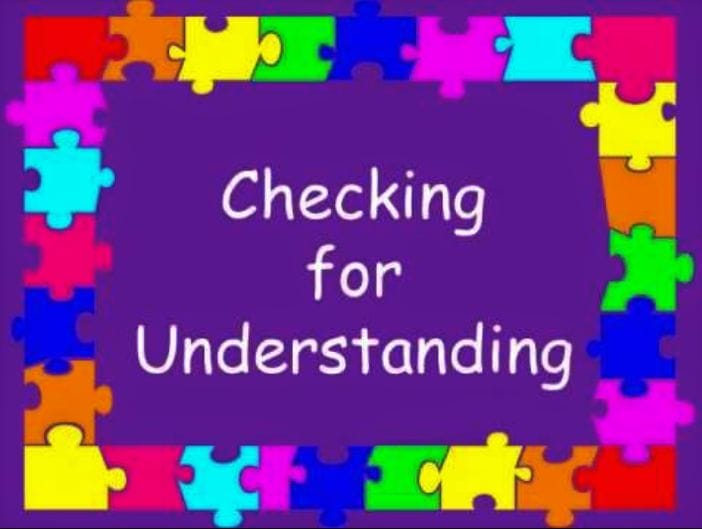
4.9 Giving feedback – Page 26-28
You will be expected to deliver a lesson and then CHECK FOR UNDERSTANDING.
Please do this during and at the end of every practice. It’s very important to do this throughout your coaching.
Check that players have understood, do they have any questions, do their actions mirror your intentions.
Try doing this in many different ways. Click the image here to learn more. Listen to ideas and suggestions, then think about how you could use these on the court in your sessions.
Please, please give encouragement throughout when things go well or when change is apparent. Remember, it doesn’t have to be perfect to praise. Sometimes making errors is a sign that things are changing and that players are trying.
Too many coaches are far too serious and don’t have time to praise the players.
Even if those players are your fellow coaches acting as your players they can be prasied!
4.10 Inheritance Coaching – coaching like you were coached
 This is a simple but a huge trap to fall into.
This is a simple but a huge trap to fall into.
It’s very easy and of course almost automatic to just repeat the things that were coached to you as a player. However, there are a number of issues waiting to catch you out.
Do you trust your memory?
If you are over 20 yrs old can you really remember what you did in the first few years of your development? If you are over 40 years old, it’s much tougher to think that far back.
What Practices & Sessions did you do as a player?
There is no guarantee that the methods and content that helped you develop are similar to that proposed by BWF. This is a common aspect seen in many courses. Coaches propose practices that don’t feature in the manual. Practices such as lining all the players at the back of the court and feeding them 1 by 1 as they move forwards with 1 shuttle. Do you know this practice?
Another dangerous area is the overuse or reliance on multi shuttle feeding.
Especially if the coach feeds with 6 players waiting for their turn.
4.11 Being Challenged by the Tutor
You must expect that the Tutor will ask you questions during the course. These could be just to check your understanding about a particular point or concept.
It could also be to give you an opportunity to explain why you did or didn’t do something. The Tutor may have a view on what you did and feel it necessary to ask you to explain more about your thoughts.
Remember that the Tutor is there to help you and to assess if you meet the criteria set out by BWF, they are just doing the task given to them.
Be careful how you respond, especially if you see this as a challenge. It’s often just a simple question:
- “Can you explain the reason behind how you did XXX”
- “How could you do that differently next time?”
- “Did that have the response you expected?”
- “Where in the manual did you find that information?”
During the course the temptation can be to sit back and expect to be taught by the tutor.
Be careful attendance only will not get you the Certificate.
– – – – – – – – – – – – – – – –
5. Do your homework
There are several points during the course when you will have to do some work at home.
My advice is, if you can, do it as soon as possible.
Pre-course
You will be sent a pack when you sign up to the course, it contains course information plus a questionnaire to compete. This will help the Tutors understand more about you and your experience.
It’s important to explain what you would like from the course and what your goals are. The more the Tutors know about you, the more they can arrange the groups.
Online component
Complete the Online part of the BWF Level 1 before you attend the course.
Remember to allow at least 2 hours as there is plenty to read, watch and complete online
Once you’ve passed, you can download a certificate as proof.
Send this to your Turor before the course
Click this image and do it now. However, you can complete it module by module as the programme is aware of how far you complete each time you leave.
Lesson Planning and Delivery
You will have to prepare and deliver between 8 – 10 lessons with your players. I recommend that you identify these players before you sign up to the course. Don’t leave it until after Day 2, you will struggle.
The easiest way is to complete the lesson planning is to use the Word templates supplied in your Pre-Course Candidate pack. Complete them electronically as many of the parts can be copied and pasted from lesson to lesson.
If you complete the forms in your own handwriting you may risk the Tutor not being able to read it. This will mean a longer final interview and lots of questions from the Tutor,
– – – – – – – – – – – – – – – –
6. Shuttletime
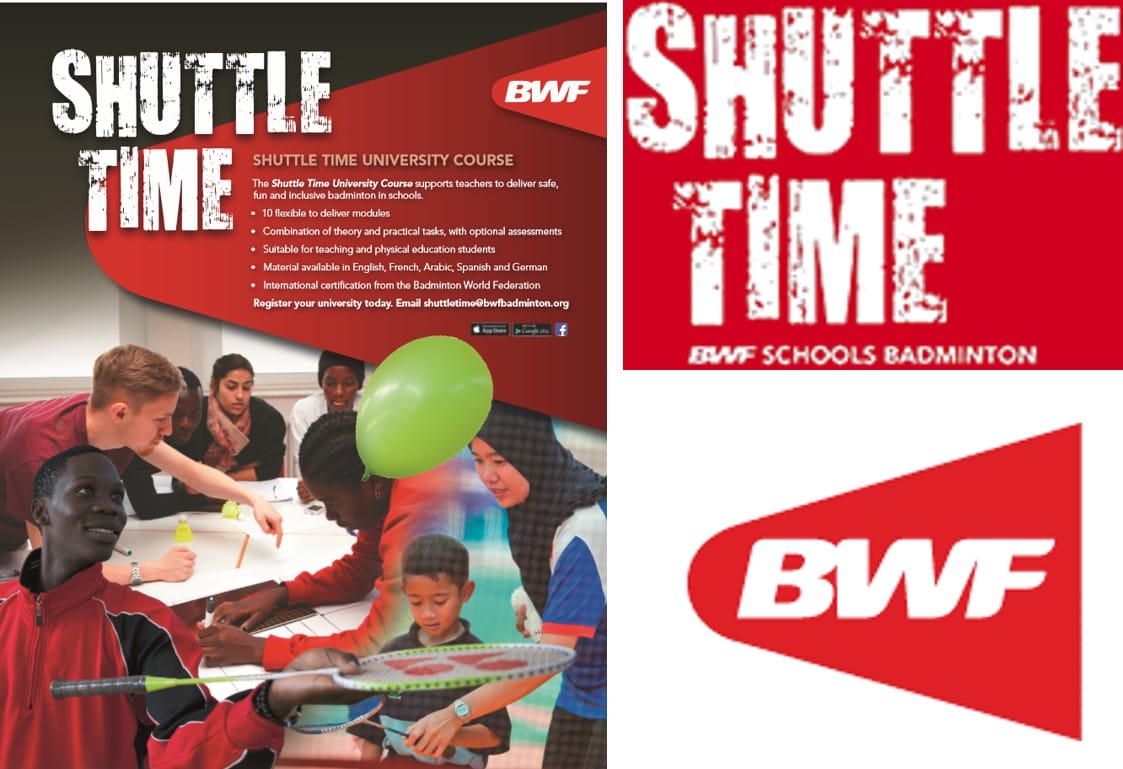 I recommend that you take this course before you do your BWFL1. You don’t have to and it’s not a requirement.
I recommend that you take this course before you do your BWFL1. You don’t have to and it’s not a requirement.
However, the benefits and value you get are huge. It will introduce to the BWF style for resources – the manual and videos.
Shuttletime is an excellent introduction to delivering (not coaching) badminton within a structured fashion over a series of 22 progressive lessons. This progressive system is something that you will need to understand on the Level 1 course.
It will also give you practice in delivering content in the style required for BWF, using their terminology
– – – – – – – – – – – – – – – –
Thank you for reading this far
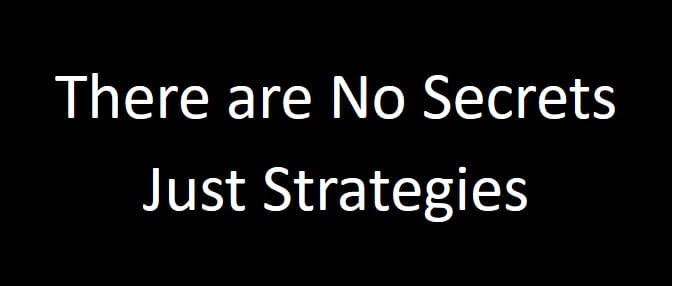 I hope that these tips not only help you complete your BWFL1 course but that you also find something to help your everyday coaching.
I hope that these tips not only help you complete your BWFL1 course but that you also find something to help your everyday coaching.
If you have completed the course and think that I’ve missed a great tip, then let me know. If it’s helped you then, of course, I will include it.
This BWF L1 coaching qualification is the start of your coaching journey. Share the information and we can all progress as a Coaches.
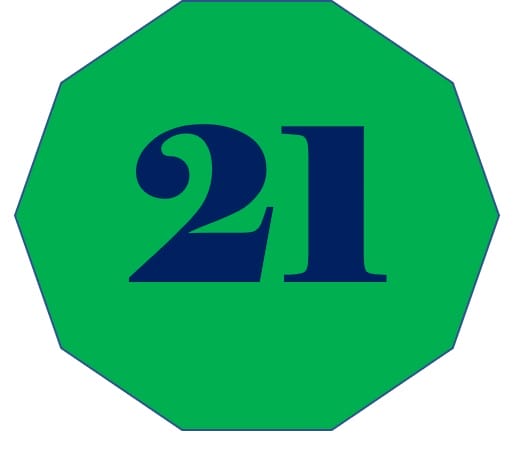
BONUS
21 Things you need to know about the BWFL1 Coaches Course
Click here to read a separate very short post that contains lots of information gained from coaches who have taken this BWF Coaches course. Their thoughts are here to help you.

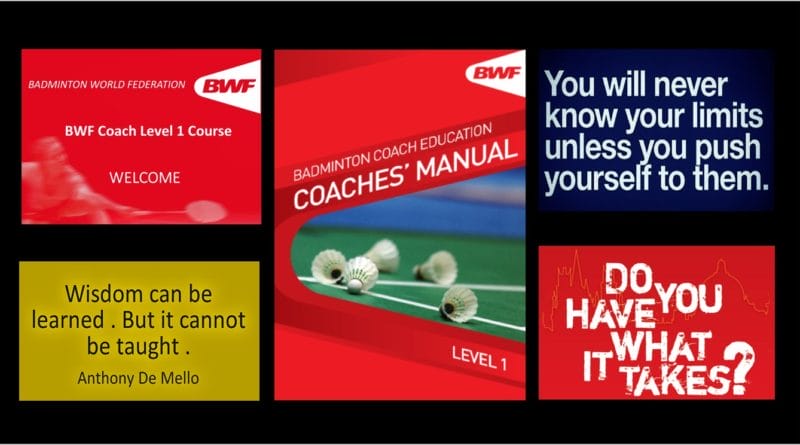
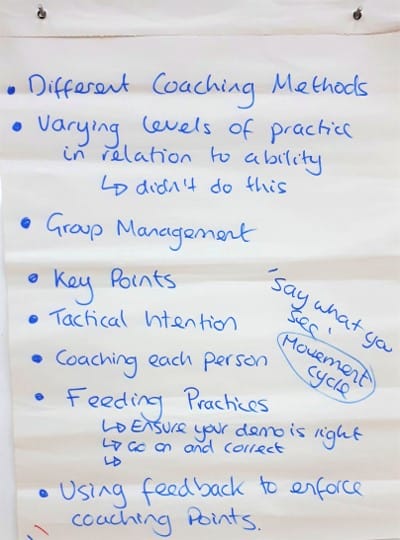 4.6 Understanding feedback
4.6 Understanding feedback